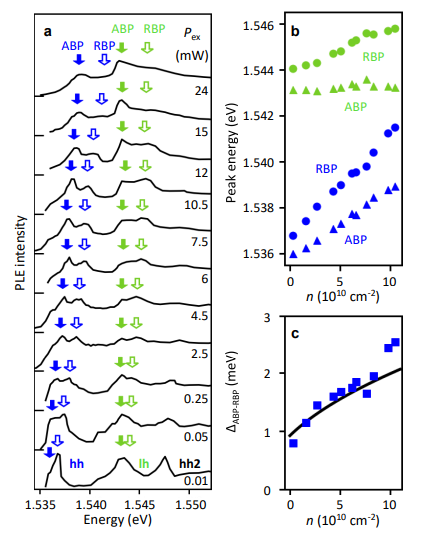Mott transition in excitonic Bose polarons |
|
For a neutral system of positive and negative charges, such as atoms in a crystal, increasing the density causes the Mott transition from bound electrons to free electrons. The density of optically generated electron-hole systems can be controlled in situ by the power of optical excitation that enables the Mott transition from excitons, the bound pairs of electrons and holes, to free electrons and holes with increasing density. These Mott transitions occur in systems of pairs of the same kind, such as atoms or excitons. However, a different type of the Mott transition can occur for Bose polarons. A Bose polaron is a mobile particle of one kind in a Bose gas of particles of another kind. For the Mott transition in polarons, the polaron states vanish with increasing density of the surrounding gas. In this paper, we present the observation of this type of the Mott transition and the measurement of the Mott transition parameter nM1/2aB in 2D excitonic Bose polarons.
E. A. Szwed, B. Vermilyea, D. J. Choksy, Zhiwen Zhou, M. M. Fogler, L. V. Butov, K. W. Baldwin, L. N. Pfeiffer. Mott transition in excitonic Bose polarons, arxiv:2504.07227 (2025). |
|
Excitonic Bose-polarons in electron-hole bilayers |
|
Bose polarons are mobile impurities dressed by density fluctuations of a surrounding degenerate Bose gas. These many-body objects have been realized in ultracold atomic gasses and become a subject of intensive studies. In this work, we show that excitons in electron-hole bilayers offer new opportunities for exploring polarons in strongly interacting, highly tunable bosonic systems. We found that Bose polarons are formed by spatially direct excitons immersed in degenerate Bose gases of spatially indirect excitons (IXs). We detected both attractive and repulsive Bose polarons by measuring photoluminescence excitation spectra. We controlled the density of IX Bose gas by optical excitation and observed an enhancement of the energy splitting between attractive and repulsive Bose polarons with increasing IX density, in agreement with our theoretical calculations.
E. A. Szwed, B. Vermilyea, D. J. Choksy, Zhiwen Zhou, M. M. Fogler, L. V. Butov, D. K. Efimkin, K. W. Baldwin, L. N. Pfeiffer. Excitonic Bose-polarons in electron-hole bilayers, arxiv:2406.15660 (2024). Nano Lett. 24, 13219 (2024). |
|
Fermi edge singularity in neutral electron-hole system |
|
In neutral dense electron-hole (e-h) systems at low temperatures, theory predicts Cooper-pair-like excitons at the Fermi energy and a BCS-like exciton condensation. Optical excitation allows creating e-h systems with the densities controlled by the excitation power. However, the intense optical excitations required to achieve high densities cause substantial heating of the e-h system that prevents the realization of dense and cold e-h systems in conventional semiconductors. In this work, we study e-h systems created by optical excitation in separated electron and hole layers. The layer separation increases the e-h recombination time and, in turn, the density for a given optical excitation by orders of magnitude and, as a result, enables the realization of the dense and cold e-h system. We found a strong enhancement of photoluminescence intensity at the Fermi energy of the neutral dense ultracold e-h system that evidences the emergence of excitonic Fermi edge singularity due to the Cooper-pair-like excitons at the Fermi energy.
D. J. Choksy*, E. A. Szwed*, L. V. Butov, K. W. Baldwin, L. N. Pfeiffer. Fermi edge singularity in neutral electron–hole system, arXiv:2209.06026 (2022), Nat. Phys. 19, 1275 (2023). |
|




